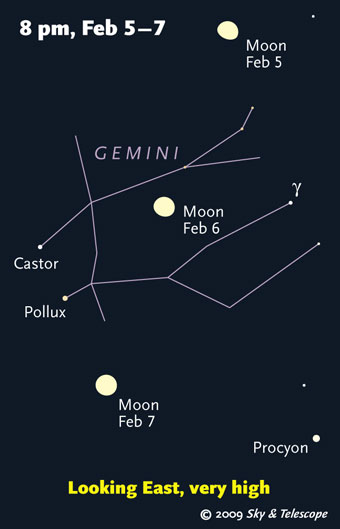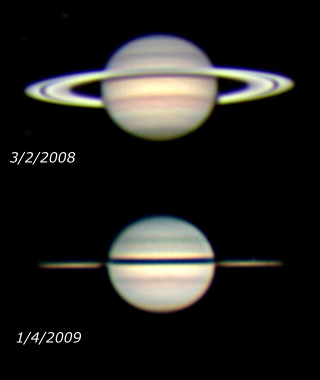Some daily events in the changing sky for January 30 – February 7.
Comet Lulin remains rather faint as it rises rapidly higher in the southeast to south before dawn. It was about magnitude 6.5 as of February 1st. Small-telescope users are spotting it easily, and so are binocular users under dark skies, but light pollution may still wipe it out for you in binoculars.
The comet is moving toward Earth and is predicted to reach 5th magnitude in late February. Full story and charts.
Meanwhile in the evening sky, Comet 144P/Kushida is brighter than originally expected as it crosses the Hyades this week. It's currently about magnitude 8.5. It passes very close by Aldebaran (3 arcminutes) on the evening Febuary 5th for the Americas, though the bright Moon is not far away. Data and finder chart (date ticks on the chart are for 0h UT, which is 7 p.m. EST on the previous date).

As the Moon waxes toward full, watch it cross Gemini in the evening sky. (These scenes are drawn for the middle of North America. European observers: move each Moon symbol a quarter of the way toward the one for the previous date.)
Sky & Telescope diagram
Friday, January 30
Saturday, January 31
Sunday, February 1
Monday, February 2
At any random time you glance up at Algol, you have a 1 in 30 chance of catching it at least 1 magnitude fainter than normal.
Tuesday, February 3
Wednesday, February 4
Thursday, February 5
Comet Lulin passes Alpha Librae, a wide binocular double star, before the first beginnings of dawn Friday morning. The pair of stars are magnitudes 2.8 and 5.3 and are 4 arcminutes apart. The comet will be fainter, about magnitude 6.3, and passing about ½° (about 8 times as far) to their north. See chart and full article.
To find when morning astronomical twilight begins at your site, make sure that your location and current time zone are in our online almanac; uncheck the Daylight Saving Time box if necessary.
Friday, February 6
Saturday, February 7
Want to become a better amateur astronomer? Learn your way around the constellations. They're the key to locating everything fainter and deeper to hunt with binoculars or a telescope. For an easy-to-use constellation guide covering the whole evening sky, use the big monthly foldout map in each issue of Sky & Telescope, the essential magazine of astronomy. Or download our free Getting Started in Astronomy booklet (which only has bimonthly maps).

The Pocket Sky Atlas plots 30,796 stars to magnitude 7.6 — which may sound like a lot, but that's less than one star in an entire telescopic field of view, on average. By comparison, Sky Atlas 2000.0 plots 81,000 stars to magnitude 8.5, typically one or two stars per telescopic field. Both atlases include many hundreds of deep-sky targets — galaxies, star clusters, and nebulae — among the stars.
Sky & Telescope
Once you get a telescope, to put it to good use you'll need a detailed, large-scale sky atlas (set of maps; the standards are Sky Atlas 2000.0 or the smaller Pocket Sky Atlas) and good deep-sky guidebooks (such as Sky Atlas 2000.0 Companion by Strong and Sinnott, the even more detailed Night Sky Observer's Guide by Kepple and Sanner, or the classic Burnham's Celestial Handbook). Read how to use them effectively.
Can a computerized telescope take their place? As Terence Dickinson and Alan Dyer say in their Backyard Astronomer's Guide, "A full appreciation of the universe cannot come without developing the skills to find things in the sky and understanding how the sky works. This knowledge comes only by spending time under the stars with star maps in hand and a curious mind." Without these, they note, "the sky never becomes a friendly place."
More beginners' tips: "How to Start Right in Astronomy".
This Week's Planet Roundup
Mercury (brightening from magnitude +1 to 0) is low in the dawn. Using binoculars, look for it just above the east-southeast horizon about 45 minutes before sunup. Watch it brighten day by day.
Venus (magnitude –4.7, near the Circlet of Pisces) is the dazzling "Evening Star" high in the southwest during and after twilight. It doesn't set until about 9 p.m. In a telescope Venus is now 31 arcseconds wide and a thick crescent 39% sunlit. Telescopically, Venus is best seen in bright twilight or even broad daylight. (It's less glary when seen against a bright sky, and it's also higher.)
Mars and Jupiter are very deep in the glow of sunrise.

William Rison of Newburg, Maryland, took these images of Saturn with the same setup 10 months apart. North is up; note that Saturn's northern latitudes are still bluer than its southern latitudes. Rison used a Meade 12-inch LX200R scope on an Astro-Physics 900GTO mount, and a Lumenera SKYnyx2-0 camera with a Barlow lens producing f/20. Video from the camera was processed with ImagesPlus 3.5 to produce the final pictures.
Sean Walker
Saturn (magnitude +0.8, near the hind foot of Leo) rises around 8 p.m. and is highest in the south around 2 a.m. Don't confuse Saturn with similarly-bright Regulus 21° (about two fist-widths at arm's length) to its upper right after they rise, and more directly to its right in the early-morning hours.
This week Saturn's rings are 1.3° to 1.4° from edge on. The rings will gradually open to 4° by late May, then will close to exactly edge-on early next September — when, unfortunately, Saturn will be out of sight practically in conjunction with the Sun.
Uranus (magnitude 5.9, in Aquarius) is below Venus at nightfall.
Neptune is lost in the sunset.
Pluto is low in the southeast before dawn.
All descriptions that relate to your horizon or zenith — including the words up, down, right, and left — are written for the world's mid-northern latitudes. Descriptions that also depend on longitude (mainly Moon positions) are for North America. Eastern Standard Time (EST) equals Universal Time (known as UT, UTC, or GMT) minus 5 hours.
To be sure to get the current Sky at a Glance, bookmark this URL:
http://SkyandTelescope.com/observing/ataglance?1=1
If pictures fail to load, refresh the page. If they still fail to load, change the 1 at the end of the URL to any other character and try again.
 0
0
Comments
You must be logged in to post a comment.